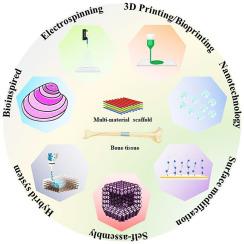多材料骨组织结构的制造策略
Q1 Computer Science
引用次数: 0
摘要
骨是一种复杂的分层组织,具有多种功能,由于其需要结构支持和与周围组织的相互作用以实现愈合,因此为工程替代提出了许多挑战。其结构、组成和生物信号的复杂性在工程功能替代中提出了巨大的挑战。传统的骨移植经常受到供体部位发病率和可用性有限等限制,推动了对先进生物材料用于骨组织工程(BTE)的追求。这篇综述强调了多材料设计作为一种战略方法的潜力,通过概述天然骨微环境来克服这些限制。首先建立对骨复杂结构的基本理解,当前的临床治疗方式,以及BTE背景下多材料设计的基本原则。具体来说,它深入研究了所使用的生物材料的不同景观,包括用于骨传导的陶瓷,用于可调机械性能的聚合物和用于承载应用的金属。然后全面探讨了多材料支架的最新进展,突出了3D打印,静电纺丝和生物打印等创新制造技术,以及增强成骨和血管化的材料的协同组合。最后,它解决了这种有前途的方法目前的局限性和未来的前景,强调需要改善体内性能和转化为临床应用。本文章由计算机程序翻译,如有差异,请以英文原文为准。

Strategies for fabricating multi-material bone tissue constructs
Bone is a complex hierarchical tissue with diverse functions that presents numerous challenges for engineering replacements due to its need for structural support and interaction with surrounding tissue for healing. The complexity of its architecture, composition, and biological signaling presents formidable challenges in engineering functional replacements. Traditional bone grafts often suffer from limitations such as donor site morbidity and limited availability, driving the pursuit of advanced biomaterials for bone tissue engineering (BTE). This review highlights the potential of multi-material design as a strategic approach to overcome these limitations by recapitulating the native bone microenvironment. It begins by establishing a foundational understanding of bone's complex structure, current clinical treatment modalities, and the fundamental principles of multi-material design within the context of BTE. Specifically, it delves into the diverse landscape of biomaterials employed, including ceramics for osteoconductivity, polymers for tunable mechanical properties, and metals for load-bearing applications. It then comprehensively explores recent advancements in multi-material scaffolds, highlighting innovative fabrication techniques like 3D printing, electrospinning, and bioprinting, as well as the synergistic combinations of materials that enhance osteogenesis and vascularization. Finally, it addresses this promising approach's current limitations and future perspectives, emphasizing the need for improved in vivo performance and translation to clinical applications.
求助全文
通过发布文献求助,成功后即可免费获取论文全文。
去求助
来源期刊

Bioprinting
Computer Science-Computer Science Applications
CiteScore
11.50
自引率
0.00%
发文量
72
审稿时长
68 days
期刊介绍:
Bioprinting is a broad-spectrum, multidisciplinary journal that covers all aspects of 3D fabrication technology involving biological tissues, organs and cells for medical and biotechnology applications. Topics covered include nanomaterials, biomaterials, scaffolds, 3D printing technology, imaging and CAD/CAM software and hardware, post-printing bioreactor maturation, cell and biological factor patterning, biofabrication, tissue engineering and other applications of 3D bioprinting technology. Bioprinting publishes research reports describing novel results with high clinical significance in all areas of 3D bioprinting research. Bioprinting issues contain a wide variety of review and analysis articles covering topics relevant to 3D bioprinting ranging from basic biological, material and technical advances to pre-clinical and clinical applications of 3D bioprinting.
 求助内容:
求助内容: 应助结果提醒方式:
应助结果提醒方式:


